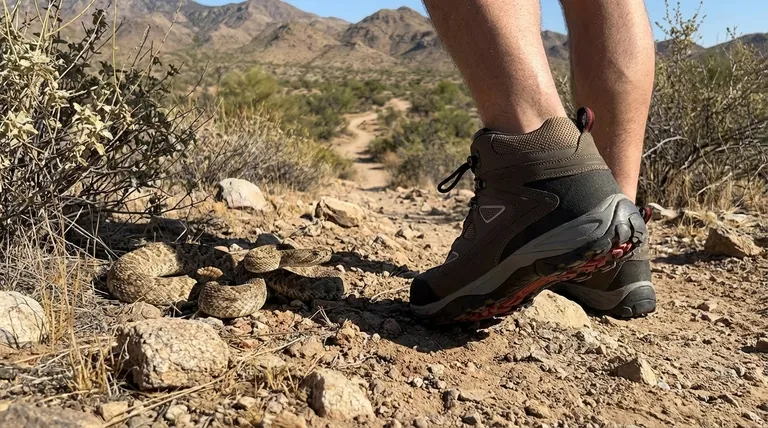To put it simply, a snake's strike is almost always a defensive action directed forward and low. The vast majority of bites occur on the ankle or lower leg because the snake is reacting to a perceived threat at very close range, such as a person about to step on or near it.
A snake's strike is not a long-range, aggressive attack but a short-range, defensive reflex. Understanding that the primary danger zone is from the foot to the knee is the most critical insight for personal safety.

The Mechanics of a Defensive Strike
A snake strike is one of the fastest movements in the animal kingdom, but it's governed by simple physical and behavioral principles. It's a reaction, not a premeditated assault.
A Forward, Limited-Range Motion
The typical strike is a rapid forward thrust from the snake's coiled or resting position. They do not have the ability to jump or launch their entire body into the air.
This movement is designed for speed and accuracy over a very short distance. The goal is to make contact with the immediate threat and retreat just as quickly.
The "Ankle Zone" as the Primary Target
Snakes bite ankles and lower legs more than any other area for a simple reason: that's where the threat is. A person walking through snake habitat presents their feet and ankles as the first and closest danger.
The snake, lying on the ground, is reacting to the object that is about to crush it. A strike above the knee is exceptionally rare and would require very unusual circumstances.
Proximity is the Trigger
A strike is a last-resort defensive measure. It is triggered when a person or animal invades the snake's personal space, which is often a matter of mere inches.
They do not "chase" people to bite them. The encounter happens because the person did not see the camouflaged snake and got too close.
What This Behavior Means for Safety
Understanding these behavioral patterns is the key to preventing snakebites. The myths about snakes are often more dangerous than the snakes themselves.
Debunking Common Myths
Many people fear that snakes will jump or strike at face or chest level. This is factually incorrect for nearly all common encounters.
The snake's behavior is predictable. The danger is almost exclusively at ground level, which makes protecting yourself much more straightforward.
The Importance of Lower Leg Protection
Because the vast majority of strikes are directed at the lower extremities, appropriate footwear is the single most effective piece of safety equipment.
Sturdy, over-the-ankle hiking boots or specialized snake gaiters provide a reliable barrier between the snake's fangs and your skin, effectively neutralizing the most common threat.
Making the Right Choice for Your Goal
Your strategy for safety should be directly informed by this predictable behavior.
- If your primary focus is personal protection: Invest in high-quality, over-the-ankle boots or snake gaiters, as this directly shields the most probable strike zone.
- If your primary focus is avoiding encounters: Cultivate constant situational awareness, watching where you place your feet and hands, as most bites are triggered by accidental, close-range contact.
Ultimately, knowing that a snake's strike is a low, defensive reaction demystifies the threat and empowers you to move through nature with confidence and respect.
Summary Table:
| Strike Characteristic | Description |
|---|---|
| Primary Direction | Forward and low, from a coiled position |
| Main Target | Ankles and lower legs |
| Range | Very short, a matter of inches |
| Nature | Defensive reflex, not an aggressive attack |
| Key Trigger | Close-range perceived threat (e.g., nearly being stepped on) |
Equip Yourself with Confidence
Understanding snake behavior is the first step to safety. The next is having the right protective gear. As a large-scale manufacturer, 3515 produces a comprehensive range of durable, over-the-ankle work and outdoor footwear designed for safety and comfort. Our boots provide a reliable barrier for hikers, field workers, and anyone in snake country, directly protecting the most common strike zone.
Protect your most vulnerable areas with footwear built for real-world dangers.
Contact us today to find the right safety footwear solution for your distributors, brand, or bulk needs.
Visual Guide

Related Products
- Safety Footwear Wholesale Manufacturer for Custom OEM/ODM Production
- Premium Grain Leather Safety Boots for Bulk Supply
- Premium Wholesale Waterproof Safety Boots High Performance Protection for Industrial Markets
- Customizable Anti-Smash Safety Boots for Wholesale & Private Label Manufacturing
- Custom Wholesale Leather Safety Boots Direct Factory Manufacturing
People Also Ask
- What do heavy duty boots do? Protect Your Feet in Demanding Work Environments
- How do safety shoes contribute to cost savings for companies? A Strategic Investment in Risk and Cost Management
- Do snake bite boots work? Your Ultimate Guide to Effective Snake Bite Protection
- What are OSHA approved shoes? Understanding the Correct Standards for Workplace Safety
- How long can you wear safety boots? The Lifespan is Determined by Wear, Not Time



















